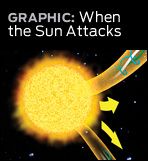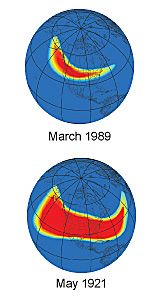""Luminous fingers of intense red, green, and violet light flicker and pulse across the northern and southern skies like a vast cosmic conflagration. Within minutes, millions of people are tweeting, texting, and blogging about the wondrous sight. But then the sky turns a deep blood red, and fascination turns to panic.
Linked to the celestial spectacle are enormous fluctuations of the magnetic field in Earth's magnetosphere, which are causing immense flows of electric current in the upper atmosphere over much of the planet. Those huge currents disturb Earth's normally quiescent magnetic field, which in turn induces surges of current in electrical, telecommunications, and other networks across entire continents. Streetlights flicker out; electricity is lost. A massive planetary blackout has occurred, leaving vast swaths of North and South America, Europe, Australia, and Asia without power.
Within a few months, the crisis has deepened. In many areas, food shortages are rampant, drinking water has become a precious commodity, and patients in need of blood transfusions, insulin, or critical prescription drugs die waiting. Normal commerce has ground to a halt, replaced by black markets and violent crime. As fatalities climb into the millions, the fabric of society starts to unravel.""
""Of course, no geomagnetic storm has ever wreaked such global havoc. But the last time we had a truly powerful storm was in 1921—decades before developed economies became utterly dependent on electrical infrastructure. The doomsday scenario described above is based closely on the warnings of numerous government panels and industry studies I've participated in during my more than 30 years of investigating the problem that extreme space weather poses to power grids. A 2008 U.S. government report prepared for the Federal Emergency Management Agency put the yearly financial impact of such an event at more than US $1 trillion. And like other reports before and since, it predicted catastrophic damage not just to electricity grids but also to oil and gas pipelines, undersea communication cables, telephone networks, and railways. Repairing that critical infrastructure would take months or even years.
Now is a good time to consider the awesome and cyclical tempestuousness of our star: Solar activity tends to occur in cycles that peak in frequency and intensity every 11 years, and the next peak is expected later this year or early the next. To be sure, not every peak—also known as a solar maximum—brings a killer storm; the last notable one occurred in March 1989. It took down Quebec's entire grid within seconds, leaving 6 million customers without power for 9 hours. A later surge in the storm destroyed a large transformer at a New Jersey nuclear plant and nearly took down U.S. power grids from the mid-Atlantic through the Pacific Northwest.""
Linked to the celestial spectacle are enormous fluctuations of the magnetic field in Earth's magnetosphere, which are causing immense flows of electric current in the upper atmosphere over much of the planet. Those huge currents disturb Earth's normally quiescent magnetic field, which in turn induces surges of current in electrical, telecommunications, and other networks across entire continents. Streetlights flicker out; electricity is lost. A massive planetary blackout has occurred, leaving vast swaths of North and South America, Europe, Australia, and Asia without power.
Within a few months, the crisis has deepened. In many areas, food shortages are rampant, drinking water has become a precious commodity, and patients in need of blood transfusions, insulin, or critical prescription drugs die waiting. Normal commerce has ground to a halt, replaced by black markets and violent crime. As fatalities climb into the millions, the fabric of society starts to unravel.""
""Of course, no geomagnetic storm has ever wreaked such global havoc. But the last time we had a truly powerful storm was in 1921—decades before developed economies became utterly dependent on electrical infrastructure. The doomsday scenario described above is based closely on the warnings of numerous government panels and industry studies I've participated in during my more than 30 years of investigating the problem that extreme space weather poses to power grids. A 2008 U.S. government report prepared for the Federal Emergency Management Agency put the yearly financial impact of such an event at more than US $1 trillion. And like other reports before and since, it predicted catastrophic damage not just to electricity grids but also to oil and gas pipelines, undersea communication cables, telephone networks, and railways. Repairing that critical infrastructure would take months or even years.
Now is a good time to consider the awesome and cyclical tempestuousness of our star: Solar activity tends to occur in cycles that peak in frequency and intensity every 11 years, and the next peak is expected later this year or early the next. To be sure, not every peak—also known as a solar maximum—brings a killer storm; the last notable one occurred in March 1989. It took down Quebec's entire grid within seconds, leaving 6 million customers without power for 9 hours. A later surge in the storm destroyed a large transformer at a New Jersey nuclear plant and nearly took down U.S. power grids from the mid-Atlantic through the Pacific Northwest.""

WORSE AND WORST
By comparing data from the geomagnetic storm in March 1989 [top] with magnetometer readings taken during the May 1921 superstorm, the author has estimated the intensity and geographic reach of the 1921 event [bottom]. The colored regions show the intense geomagnetic field disturbances caused by the eastward electrojet—a large electric current that builds up in the atmosphere—over North America. Not only was the 1921 storm more intense than the 1989 storm, but it had a much larger geographic foot-print. Unfortunately, no data exist to depict the 1921 storm’s much larger westward electrojet, but it would have engulfed much of the planet.
By comparing data from the geomagnetic storm in March 1989 [top] with magnetometer readings taken during the May 1921 superstorm, the author has estimated the intensity and geographic reach of the 1921 event [bottom]. The colored regions show the intense geomagnetic field disturbances caused by the eastward electrojet—a large electric current that builds up in the atmosphere—over North America. Not only was the 1921 storm more intense than the 1989 storm, but it had a much larger geographic foot-print. Unfortunately, no data exist to depict the 1921 storm’s much larger westward electrojet, but it would have engulfed much of the planet.
Source: Andrea Grygo/Storm Analysis Consultants

From where we sit, the sun seems quiet enough. And yet it is constantly bombarding Earth with electrons, protons, and radio through X-ray waves. The charged particles are ejected from the star's upper atmosphere and carried through space at a clip of 300 to 400 kilometers per second, arriving at our atmospheric doorstep about four days after leaving the sun. Under normal circumstances, this solar wind produces only negligible effects on Earth.
Occasionally, though, the sun erupts violently, emitting solar flares or throwing out coronal mass ejections consisting of billions of tons of charged particles. At such times, the solar wind blows considerably harder, at speeds of over 2000 km/s, organized into strong magnetic fields and with particle densities and temperatures an order of magnitude higher than normal. When it hits Earth's upper atmosphere, the solar wind connects with and expands Earth's magnetosphere, including the long tail-like portion that streams out from the nighttime side of the planet. This magnetotail swells and elongates until it becomes unstable and breaks in two.
The part of the magnetotail that's no longer attached to Earth drifts off into space, while the rest snaps back violently, like a broken rubber band. In the process it forces plasma back into Earth's upper atmosphere, where a large current of more than a million amperes—called an electrojet—builds up at an altitude of about 100 km and produces brilliant auroras. In average-size storms, this electrojet extends only over the globe's higher latitudes, like a halo circling one of the poles. But during very large storms, such as those in 1989 and 1921, it can also reach down to the lower latitudes, where most of the world's population and its infrastructure dwell.
That's not the only means by which the sun can upset Earth's geomagnetic balance. Coronal mass ejections that are big enough can collide directly with Earth's magnetosphere, releasing enough energy to collapse it on the daytime side of the planet from more than 64 000 km to less than 25 000 km in just a minute or two. The solar wind can buffet the magnetosphere, creating giant electromagnetic waves, much as hurricane winds kick up surf on the ocean. At lower latitudes, space weather can set off geomagnetic activity of a lesser intensity but longer duration, which can be as damaging to electric grids near the equator as other types of storms can be at higher latitudes.
But how does all this space weather cause damage down on the ground? It's a multistep process. First, the intense magnetic field variations in the magnetosphere induce electric fields and currents over large areas of Earth's surface. In turn, this geoelectric field creates what are known as geomagnetically induced currents, or GICs, which flow in any available conductor, including high-voltage transmission lines, oil and gas pipelines, railways, and undersea communications cables. These interconnecting networks essentially act as giant antennas that channel the induced currents from the ground. Hit with a 300-ampere GIC, a high-voltage transformer's paper tape insulation will burn, its copper winding will melt, and the transformer will fail, either right then and there or in the future.""

Source: Peter Warner/Storm Analysis Consultants; Map: John MacNeill
""Lights Out: A simulation of an extreme geomagnetic storm at 50 degrees geomagnetic latitude shows a widespread collapse of the power grid in the eastern and northwest portions of the United States, which together have a population of more than 130 million people. The black lines indicate extra-high-voltage transmission lines and major substations. The red dots indicate the locations and magnitude of the geomagnetically induced currents that would flow across the network. In this scenario, more than 300 large EHV transformers would either fail or suffer permanent damage.
High-voltage power grids are designed to withstand the loss of any single important element, such as a substation transformer, and then recover within a half hour or so. For a terrestrial storm like a hurricane or a tornado, this approach works well. But a severe geomagnetic storm covering an entire continent would cause multiple failures all at once. During the first 30 seconds of the 1989 storm, the Quebec grid experienced 15 simultaneous failures—and the unsurprising result was a province-wide blackout. And that storm, remember, was far from the worst Earth has seen.""
""It took scientists a while to make the connection between something happening on the sun and something happening on Earth. Given the separation between the two events of hours or days and 150 million km, maybe that's not too surprising. The first person to begin connecting the dots was a British amateur astronomer named Richard Carrington, who while doing daily sunspot observations saw a huge "white light" flare on the sun on 1 September 1859. This flare was both preceded and followed by incredible bloodred auroral displays that engulfed the planet from the poles to the tropics.""
So What Does All This Really Mean For Problematic CME's Reaching Earth's Power Grid?





No comments:
Post a Comment